steering SSANGYONG TURISMO 2013 User Guide
[x] Cancel search | Manufacturer: SSANGYONG, Model Year: 2013, Model line: TURISMO, Model: SSANGYONG TURISMO 2013Pages: 796, PDF Size: 78.99 MB
Page 542 of 796
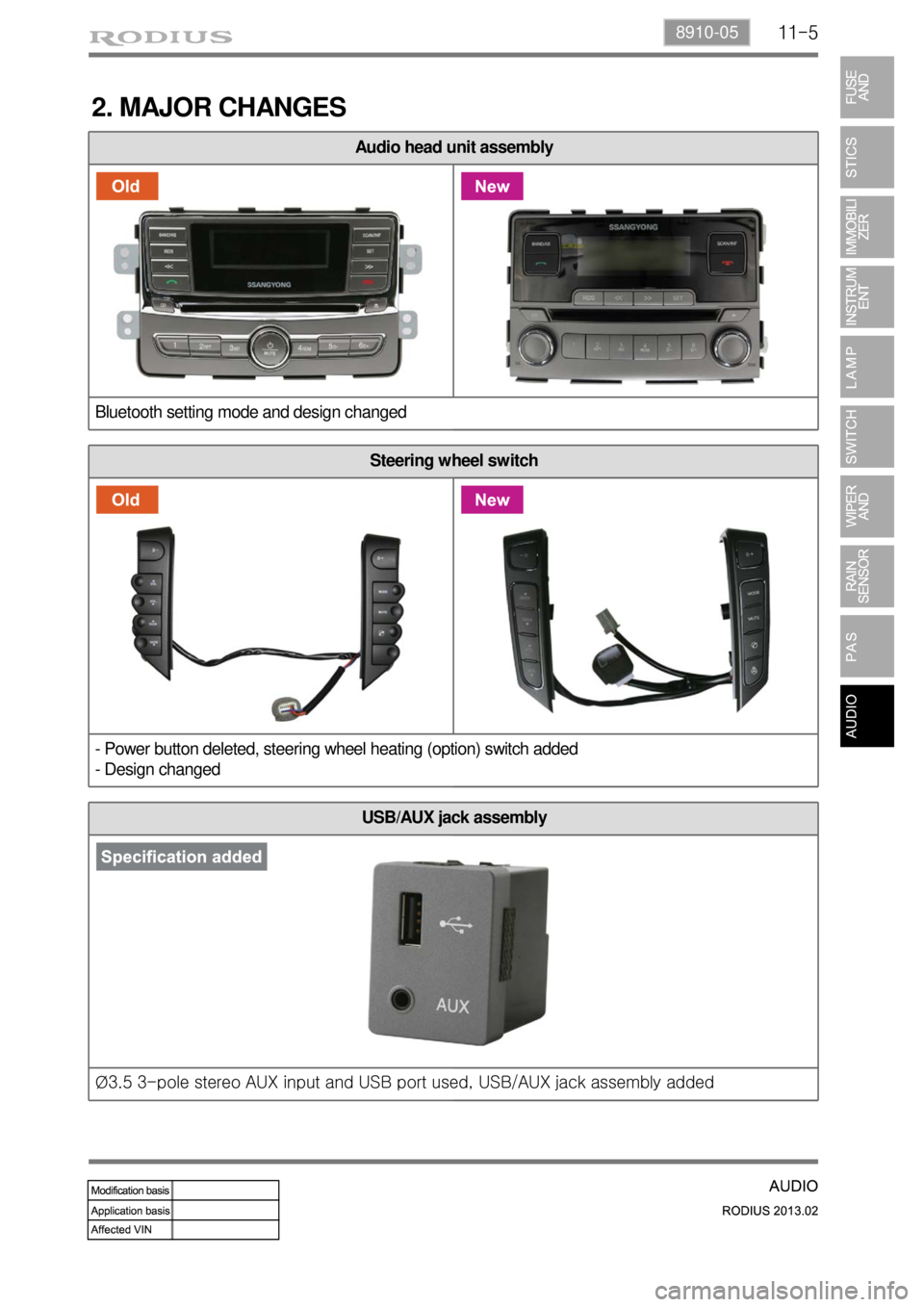
11-58910-05
Audio head unit assembly
Bluetooth setting mode and design changed
Steering wheel switch
- Power button deleted, steering wheel heating (option) switch added
- Design changed
2. MAJOR CHANGES
USB/AUX jack assembly
Ø3.5 3-pole stereo AUX input and USB port used, USB/AUX jack assembly added
Page 545 of 796
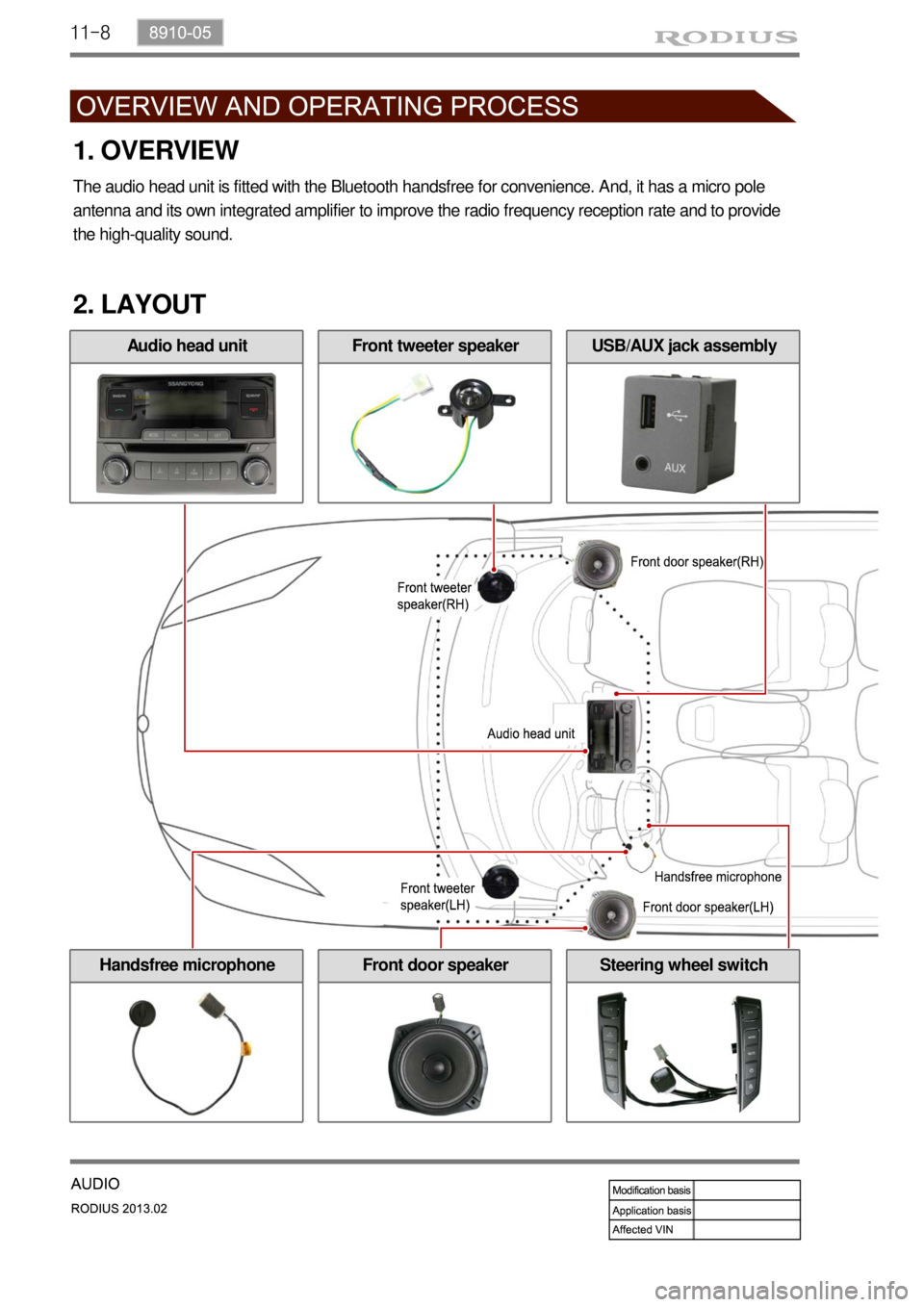
11-8
Front door speaker
2. LAYOUT
Handsfree microphoneSteering wheel switch
1. OVERVIEW
The audio head unit is fitted with the Bluetooth handsfree for convenience. And, it has a micro pole
antenna and its own integrated amplifier to improve the radio frequency reception rate and to provide
the high-quality sound.
Audio head unitFront tweeter speakerUSB/AUX jack assembly
Page 546 of 796
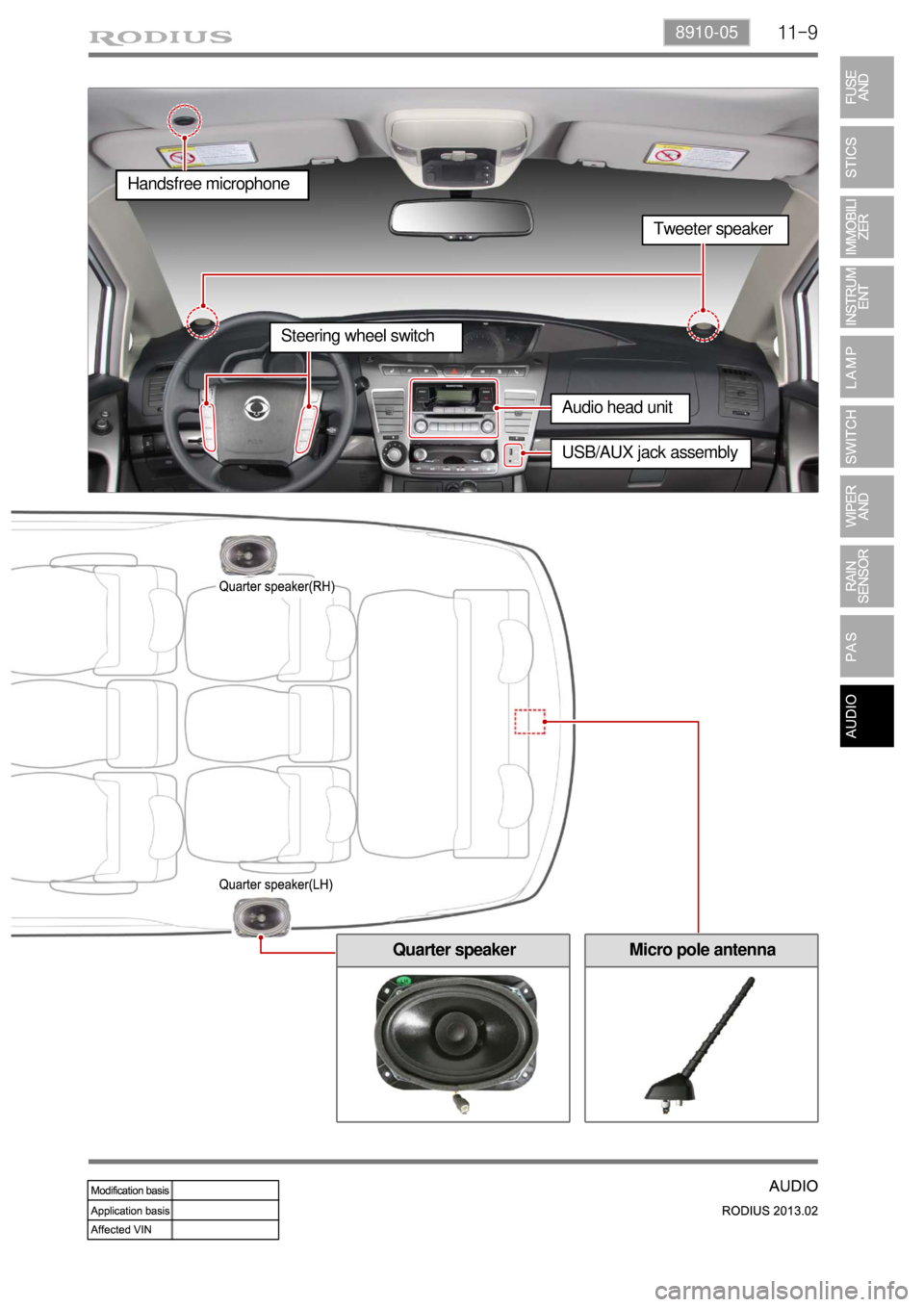
11-98910-05
Micro pole antennaQuarter speaker
Handsfree microphone
Tweeter speaker
Audio head unit
Steering wheel switch
USB/AUX jack assembly
Page 547 of 796
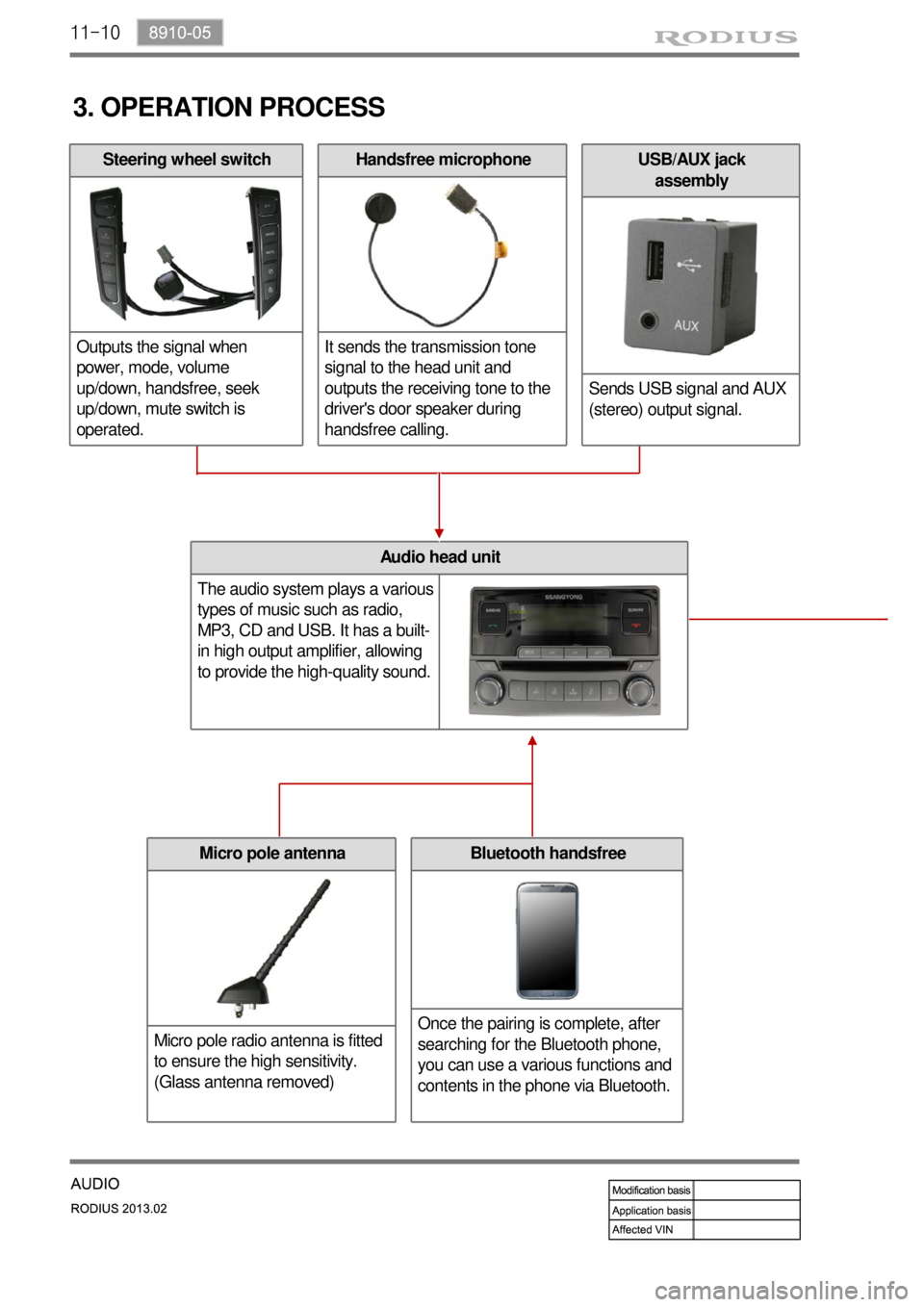
11-10
USB/AUX jack
assembly
Sends USB signal and AUX
(stereo) output signal.Handsfree microphone
It sends the transmission tone
signal to the head unit and
outputs the receiving tone to the
driver's door speaker during
handsfree calling.Steering wheel switch
Outputs the signal when
power, mode, volume
up/down, handsfree, seek
up/down, mute switch is
operated.
3. OPERATION PROCESS
Audio head unit
The audio system plays a various
types of music such as radio,
MP3, CD and USB. It has a built-
in high output amplifier, allowing
to provide the high-quality sound.
Micro pole antenna
Micro pole radio antenna is fitted
to ensure the high sensitivity.
(Glass antenna removed)Bluetooth handsfree
Once the pairing is complete, after
searching for the Bluetooth phone,
you can use a various functions and
contents in the phone via Bluetooth.
Page 627 of 796

07-12
3. WHEEL ALIGNMENT
Wheel alignment (adjustment of Camber, Caster and Toe) is part of standard automobile maintenance
that consists of adjusting the angles of the wheels so that they are set to the specification. The purpose
of these adjustments is to reduce tire wear, and to ensure that vehicle travel is straight and true (without
"pulling" to one side). Alignment angles can also be altered beyond the specifications to obtain a specific
handling characteristic.
When viewed from the top, the distance between the tire centers is smaller in the front than in
the rear. ▶
Side slip protection
Parallel front wheels rotation (straight ahead driving is ensured by toe-in to prevent the wheels from tilting
outwards by the camber while driving)
Prevention of uneven (outward) tire wear Prevention of toe-out from wearing of steering linkage -
-
-
1) Toe-in
The difference of measured distances between the front ends of the tires (A) and the rear ends of the
tires (B) along the same axle when viewed the wheels from the top.
Toe-inFront0.˚±0.10˚
Rear0.48˚±0.15˚
Necessity for Wheel Alignment ▶
Wheel alignment consists of adjusting the angles of the wheels so that they are perpendicular to the
ground and parallel to each other. The purpose of these adjustments is maximum tire life and a vehicle
that tracks straight and true when driving along a straight and level road.
The symptoms of a vehicle that is out of alignment are:
Uneven or rapid tire wear
Pulling or drifting away from a straight line
Wandering on a straight level road
Spokes of the steering wheel off to one side while driving on a straight and level road.
Page 628 of 796
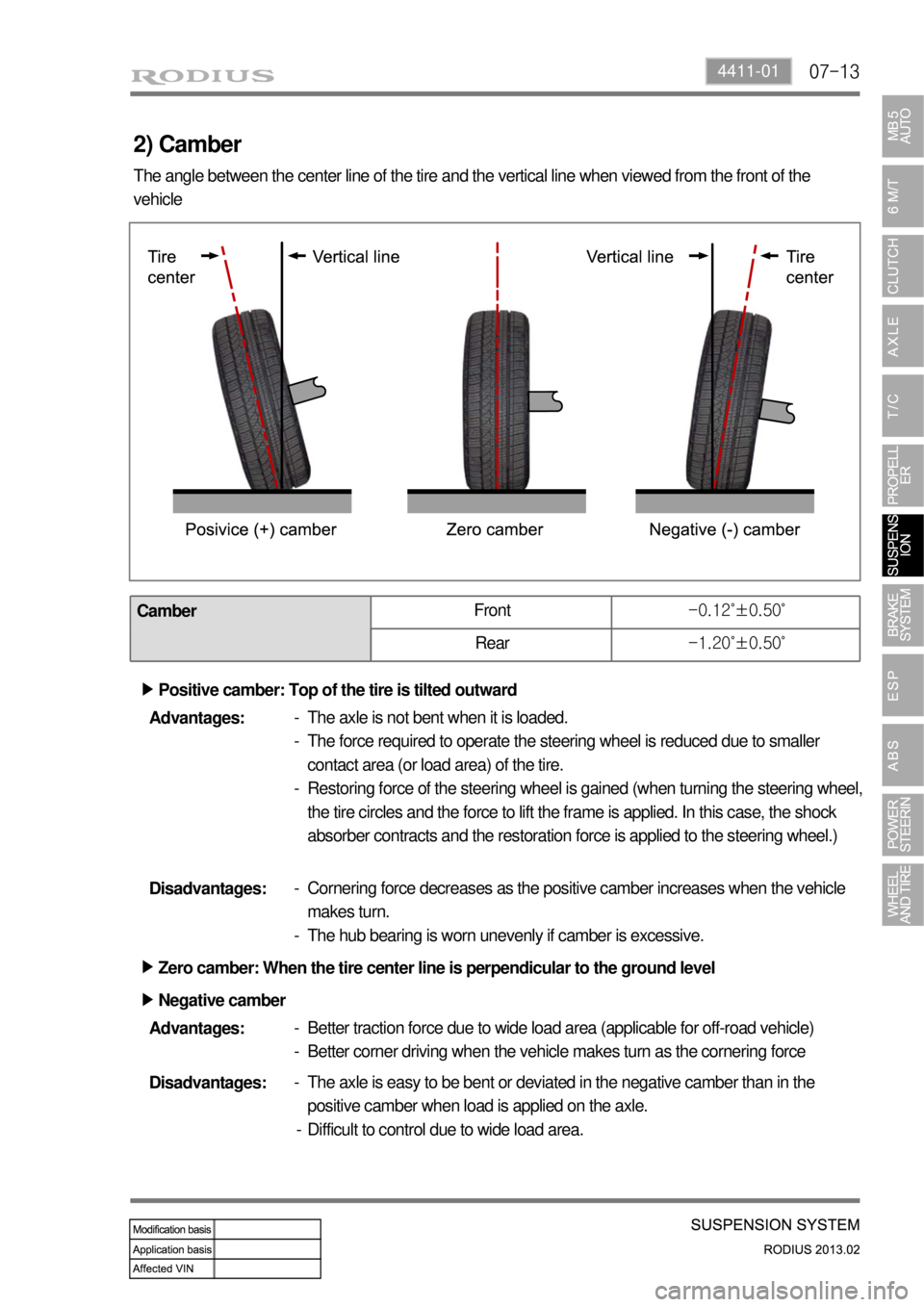
07-134411-01
2) Camber
The angle between the center line of the tire and the vertical line when viewed from the front of the
vehicle
CamberFront-0.12˚±0.50˚
Rear-1.20˚±0.50˚
Zero camber: When the tire center line is perpendicular to the ground level ▶
Disadvantages:The axle is easy to be bent or deviated in the negative camber than in the
positive camber when load is applied on the axle.
Difficult to control due to wide load area. -
- Advantages:Better traction force due to wide load area (applicable for off-road vehicle)
Better corner driving when the vehicle makes turn as the cornering force -
- Negative camber ▶Disadvantages:Cornering force decreases as the positive camber increases when the vehicle
makes turn.
The hub bearing is worn unevenly if camber is excessive. -
- Advantages:The axle is not bent when it is loaded.
The force required to operate the steering wheel is reduced due to smaller
contact area (or load area) of the tire.
Restoring force of the steering wheel is gained (when turning the steering wheel,
the tire circles and the force to lift the frame is applied. In this case, the shock
absorber contracts and the restoration force is applied to the steering wheel.) -
-
- Positive camber: Top of the tire is tilted outward ▶
Page 629 of 796

07-14
3) Caster
The angle between the vertical line and king pin, which fixes the steering knuckle and front axle,
(steering column which connects the top and bottom ball joints in the independent axle type) when
viewed the tires from the side.
CasterFront4.80˚±0.50˚
Rear -
Disadvantages:Impact from the road is transferred to the steering wheel (steering wheel turns)
Poor straightness -
- Advantages:Directional force to go straight (following control)
Restoring force of the wheel (restored to the straight ahead direction)
Prevention of wheel shimmy (wheels wobble left and right) -
-
-
Negative caster: ▶Top of the king pin is tilted forward from the vertical line of the wheel center
when viewed the tires from the side Positive caster: ▶
With considering the height difference between the wheel centers of the front and rear
wheels. (Under standard condition that the vehicle is on a level ground) Caster: ▶
Advantages:Smaller turning radius -Top of the king pin is tilted backward from the vertical line of the wheel center
when viewed the tires from the side
Page 649 of 796

09-34891-01
1. SPECIFICATIONS
1) Pressure Sensor
UnitDescription
Location
ABS ESP
HECU
(Hydraulic &
Electronic Control
Unit) CPU:MCU60 (32bit)
Clock Frequency:
28 MHz
Memory: 128~256 KB CPU:MCU60 (32bit)
Clock Frequency:
28 MHz
Memory:256~512 KB Under the front washer
reservoir
Wheel Speed
SensorActive type wheel speed
sensorActive type wheel speed
sensorOn each wheel
Front air gap:
0.3 ~ 1.3mm,
Rear air gap:
0.3 ~ 1.3 mm
Steering Wheel
Angle SensorN/AMaximum angular speed:
1500°/sec
Operating voltage:
9~16 VUnder the steering
wheel
Sensor ClusterN/AIntegrated with yaw rate
sensor and lateral sensorUnder the audio
assembly
Pressure Sensor
N/A Analog outputUnder the master
cylinder
Description Specification
Supplying voltage approx. 5 V (4.75~5.25 V)
Max. pressure 350 bar
Page 650 of 796

09-4
2) Sensor Cluster
3) Steering Wheel Angle Sensor
Air gap between sensor and rotorFront 0.3 ~ 1.3 mm
Rear 0.3 ~ 1.3 mm
Current (at 2.75 km/h)IHIGH : 14 mA
ILOW : 7 mA
Voltage (when turning the steering wheel one turn per second) 7.5 ~ 20 V
4) Active Wheel Speed Sensor
Operating voltage 9~16 V
Maximum output current 10 mA
Max. current consumption100 ma
Maximum detection angle speed 1500˚/s
Operating temperature -30~75℃
Supplying voltage 9 to 16 V (battery voltage)
Description Specification
Description Specification
Description Specification
Supplying voltage approx. 5 V (4.75~5.25 V)
Output voltage while in stationary approx. 2.5 V (Ignition ON)
Output range 0.2~4.8 V
Operating start speed4˚/s
Page 651 of 796
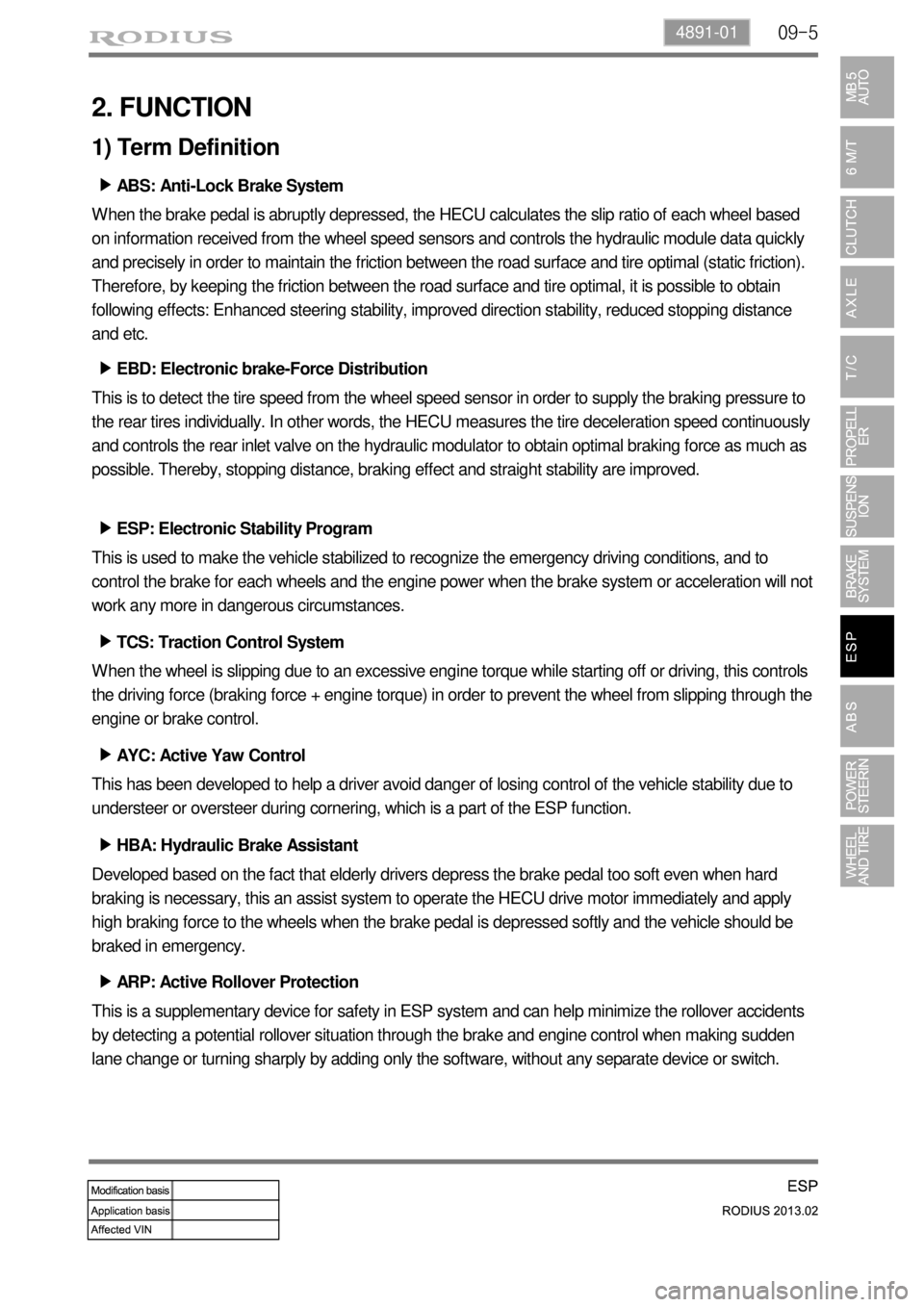
09-54891-01
2. FUNCTION
1) Term Definition
ABS: Anti-Lock Brake System ▶
When the brake pedal is abruptly depressed, the HECU calculates the slip ratio of each wheel based
on information received from the wheel speed sensors and controls the hydraulic module data quickly
and precisely in order to maintain the friction between the road surface and tire optimal (static friction).
Therefore, by keeping the friction between the road surface and tire optimal, it is possible to obtain
following effects: Enhanced steering stability, improved direction stability, reduced stopping distance
and etc.
EBD: Electronic brake-Force Distribution ▶
This is to detect the tire speed from the wheel speed sensor in order to supply the braking pressure to
the rear tires individually. In other words, the HECU measures the tire deceleration speed continuously
and controls the rear inlet valve on the hydraulic modulator to obtain optimal braking force as much as
possible. Thereby, stopping distance, braking effect and straight stability are improved.
ESP: Electronic Stability Program ▶
This is used to make the vehicle stabilized to recognize the emergency driving conditions, and to
control the brake for each wheels and the engine power when the brake system or acceleration will not
work any more in dangerous circumstances.
TCS: Traction Control System ▶
When the wheel is slipping due to an excessive engine torque while starting off or driving, this controls
the driving force (braking force + engine torque) in order to prevent the wheel from slipping through the
engine or brake control.
AYC: Active Yaw Control ▶
This has been developed to help a driver avoid danger of losing control of the vehicle stability due to
understeer or oversteer during cornering, which is a part of the ESP function.
HBA: Hydraulic Brake Assistant ▶
Developed based on the fact that elderly drivers depress the brake pedal too soft even when hard
braking is necessary, this an assist system to operate the HECU drive motor immediately and apply
high braking force to the wheels when the brake pedal is depressed softly and the vehicle should be
braked in emergency.
ARP: Active Rollover Protection ▶
This is a supplementary device for safety in ESP system and can help minimize the rollover accidents
by detecting a potential rollover situation through the brake and engine control when making sudden
lane change or turning sharply by adding only the software, without any separate device or switch.